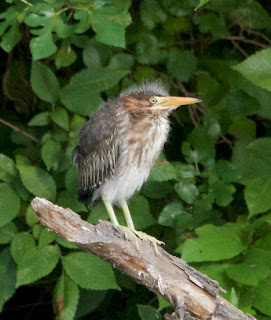Green Heron Chick, Clutch 4
Both Green Heron Chicks, Clutch 5
Green Heron Chick, Clutch 5
Both Green Heron Chicks, Clutch 5
Oldest Green Heron Chick, Clutch 5
Green Heron Chick, Clutch 4
Saturday, 07-30-16
0750-0842 hrs./74-75 degrees F/mostly cloudy-rain/4 mph ENE winds/88% RH
There were not a lot of photos taken, due to unfavorable weather conditions, but there were
at least double what was posted. These chicks all have to grow fast, as by months end, Green
Herons will begin to realize that migration is nearly upon them. Some can go nearby as southern Texas for the winter, yet others will cross the Gulf of Mexico, which I am nearly sure that this
family does. Six hundred miles across the water to the Yucatan peninsula alone is a long distance
for a bird that was born this summer, so they must be well fed and strong enough to make it. If
not, they will simply drop in the water out of sheer exhaustion and die. Only half of all neotropical
migrants survive migration.
Green Heron Chick, Clutch 4
Green Heron Chick, Clutch 5
Both Green Heron Chicks, Clutch 5
Green Heron Chick, Clutch 5
Green Heron Chick, Clutch 5
1st Summer Green Heron
Green Heron Chick, Clutch 5
Green Heron Chick, Clutch 4
1st Summer Green Heron
Leading Clutch 4 Through Center Trees
Green Heron Chick, Clutch 4
Within Center Trees
1st Summer Green Heron
1st Summer Green Heron
Ditto
Ditto
Green Heron Chick, Clutch 5
Ditto
Ditto
1st Summer Green Heron
2016 Clutch 1, 2, or 3
Juvenile Green Heron
Sunday, 07-31-16
0716-0856 hrs./74-80 degrees F/partly cloudy/s. The word for the d winds/67% RH
This day included a lot of action for the youngsters, who were all beside themselves in their
own little word for the day was to get clutch 5 moving quickly, including as much flight as
possible.
Clutch 4 had been making short flights from the right side snag where they'd been hanging
their hats and were rather high in the tree. At one point, three little ones were sitting on a branch
once the baby decided to get up. The eldest usually perched on the snag.
Our parent, the 1st summer bird, would come in for feeding clutch 5, then eventually got both
clutches to mingle. They were brought along the center trees to the left snag where clutch 5 is.
Most of the clutch 4 birds are a little older, so their moving made the most sense, even though
there are more of them.
At one point, one of the young ones was missing, so both 1st summer birds were out searching
until the youngster was discovered in the center trees. It caused a minor panic, but fortunately,
it didn't last long. The birds all mingled well, especially clutch 4, who were completely out of their element. They managed to explore, which is a necessity in a new area.
The first summer Green Herons were right on top of things with their outstanding parental skills
and new stimuli provided for both clutches, especially so late in the season.

























No comments:
Post a Comment